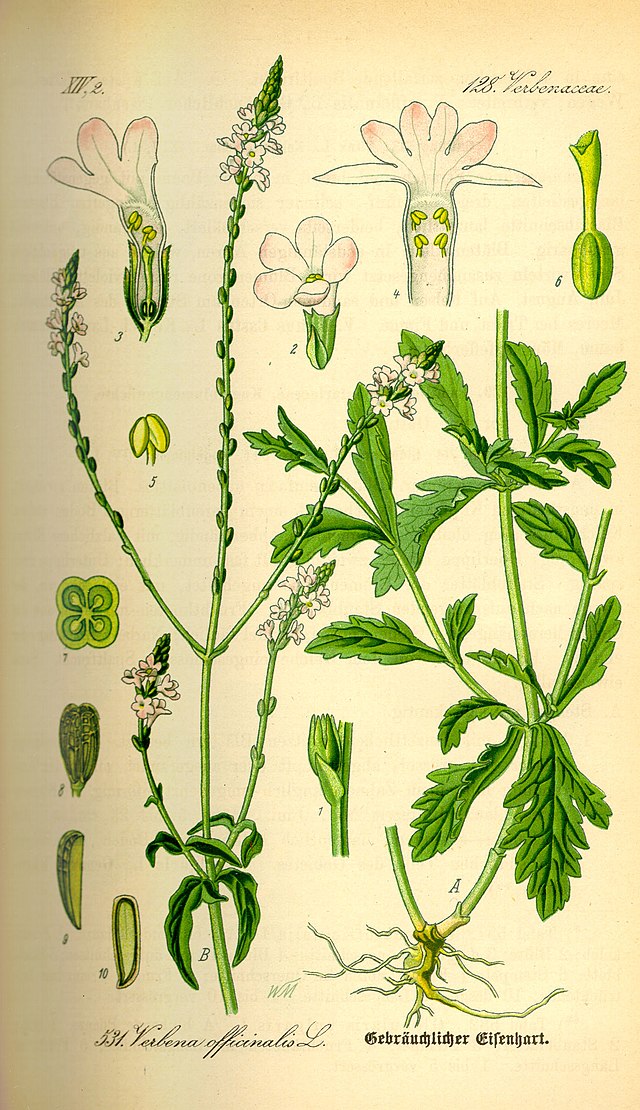Dies ist eine alte Version des Dokuments!
Verbenaceae - common vervain, common verbena, Echtes Eisenkraut
Annual herb, native to the northern hemisphere, 30-80cm high; stem erect, square, branched at the top; leaves opposite, lower ones petioled; small flowers, pale-pink to pale-lilac; inflorescence a narrow spike.
Common verbena should not be confused with lemon verbena (Aloysia citrodora, which emit a powerful scent reminiscent of lemon when bruised).
„The name Eisenkraut itself can be traced back to the cultic use of this plant: it should be the best remedy for wounds by iron weapons“ http://de.wikipedia.org/wiki/Echtes_Eisenkraut
„Verbena officinalis has traditionally been used in herbal medicine in Navarra, Spain, in the treatment of topical inflammation. Due to the anti-inflammatory activity of Verbena officinalis 50% methanolic extract in i.p. and topical administration, the effects of several formulations were prepared and studied using carrageenan-induced edema and formalin testing. Piroxicam gel and methyl salicylate ointment were studied as positive control for anti-inflammatory and analgesic activity, respectively. The edema inhibition of the preparations containing extract at the doses of 1–3% w/w were significantly different from the control group. The anti-inflammatory effect of VO-3% was similar to the effect of piroxicam gel 3 h after carrageenan injection. The analgesic activity of topical preparation with more than 2.5% w/w was observed in the early phase. This activity was observed in concentrations of more than 2% w/w in the late phase. The topical analgesic activity of the extract was less than the analgesic activity of methyl salicylate ointment.“ [Anti-inflammatory and analgesic activity of the topical preparation of Verbena officinalis L., M.I. Calvo, Journal of Ethnopharmacology, Vol.107 (3), 2006, 380–382]
„…50% methanolic extract and caffeoyl derivatives could potentially be considered as excellent and readily available sources of natural antifungal and antioxidant compounds.“ [Antioxidant and Antifungal Activity of Verbena officinalis L. Leaves, E. Casanova, J. M. García-Mina, M. I. Calvo, Plant Foods for Human Nutrition Vol.63 (3), 2008, 93-97]
„A pentacyclic triterpenoid, ursolic acid (1), two iridoid glucosides, verbenalin (2) and hastatoside (3), and a phenylpropanoid glycoside, verbascoside (4), were isolated from Verbena officinalis Linn. (Verbenaceae), a plant listed in the Chinese Pharmacopoeia and the British Herbal Pharmacopoeia…Tender parts of the plant were rich in all of these constituents (0.24–0.34%, w/w) while the roots, which are not official in the Pharmacopoeias, contained a maximum amount (0.32%, w/w) of the bioactive verbascoside (4).“ [Quantitative determination of the major constituents of Verbena officinalis using high performance thin layer chromatography and high pressure liquid chromatography. Mundkinajeddu Deepak, Sukhdev Swami Handa, Phytochemical Analysis, Vol.11 (6), 2000, 351–355]

